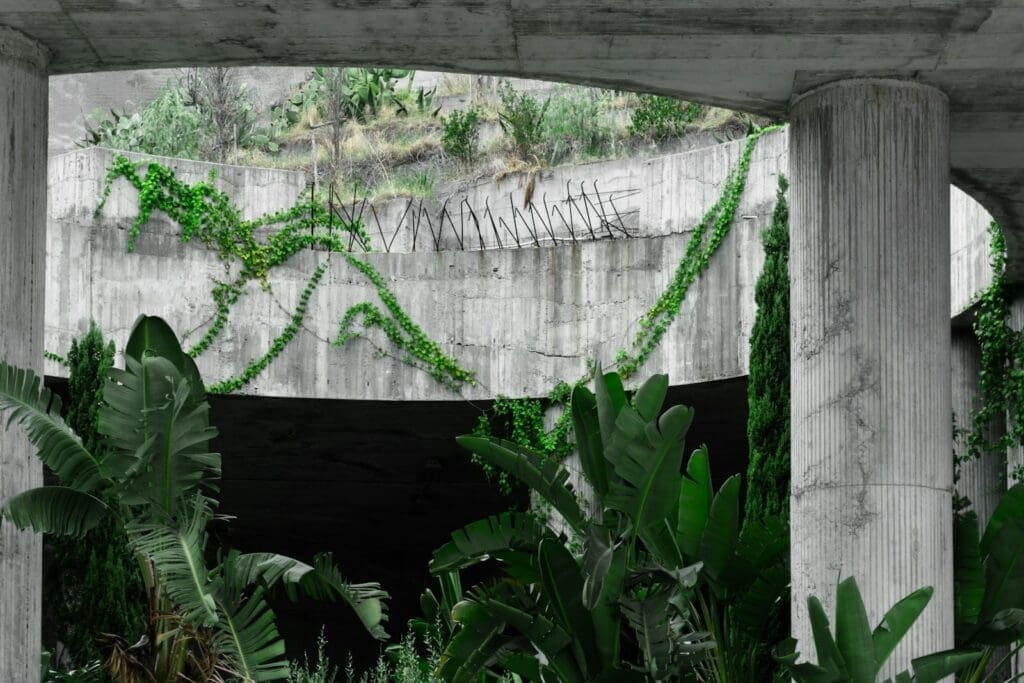Introduction to Eco-Friendly Cement Alternatives
Did you know that traditional Portland cement is responsible for around 8% of the world’s CO2 emissions?
It’s mind-boggling, right?
Breathe easy, though, because better, greener options are emerging in the area of construction materials. In this article, we’re exploring the world of green alternatives to Portland Cement.
From introducing you to the reasons why Portland cement has become a cause for concern due to its hefty ecological footprint, to enlightening you with a range of greener alternatives that are eco-friendly, efficient and made from recycled materials, we’re making sure you’re in the know. Also, we’ll be taking a closer look at each alternative’s unique benefits and characteristics.
Let’s explore a more sustainable future for the construction industry – and we’ll start by pouring the foundation with this article.
Table of Contents
Exploring Green Alternatives to Portland Cement

Introduction to Sustainable Construction Materials
Construction practices are evolving to include more environmentally-friendly materials. One major area of focus is finding alternatives to Portland cement, which is known for its significant carbon footprint. Below, we’ll discuss what makes Portland cement problematic and introduce you to some greener materials.
Why Seek Alternatives to Portland Cement?
Portland cement is a key ingredient in concrete production, but its manufacturing process releases a substantial amount of carbon dioxide (CO2). This happens primarily due to:
- Limestone calcination, releasing CO2 as a byproduct
- Energy-intensive kiln operations
Green Alternatives to Portland Cement
Fly Ash
Fly ash is a byproduct from the combustion of coal in power plants. It has pozzolanic properties, which means it can react with calcium hydroxide to form compounds possessing cementitious properties.
- Reduces greenhouse gas emissions
- Utilizes industrial waste
- Improves concrete durability and workability
Slag Cement
Also known as ground granulated blast furnace slag (GGBS), this is a byproduct from steel production. It can be used as a partial replacement for Portland cement.
- Reduces CO2 emissions
- Enhances concrete strength and durability
- Reduces thermal cracking
Geopolymer Cement
Geopolymer cement involves the chemical reaction of aluminosilicate materials (like fly ash or slag) activated with alkaline solutions.
- Lower carbon footprint than Portland cement
- High thermal and chemical resistance
- Potential use in various applications
Limestone Calcined Clay Cement (LC3)
LC3 is a blend of limestone, calcined clay, and clinker. This mixture reduces the amount of clinker required, significantly cutting CO2 emissions.
- Reduces clinker content by up to 50%
- Lower energy consumption
- Excellent durability and performance
Comparison Table of Green Cement Alternatives
| Material | CO2 Emissions Reduction | Key Benefits |
|---|---|---|
| Fly Ash | Up to 30% | Utilizes waste, improves durability |
| Slag Cement | Approximately 48% | Enhances strength and reduces cracking |
| Geopolymer Cement | Up to 80% | High thermal and chemical resistance |
| Limestone Calcined Clay Cement | Up to 40% | Lower energy use, durable |
Exploring and adopting these green alternatives to Portland cement can greatly reduce the environmental impact of construction projects. Each option offers unique benefits in terms of performance and sustainability. For more in-depth insights, you can explore this resource on green cements from the American Concrete Institute.
Understanding the Impact of Portland Cement
Portland cement, despite being one of the most extensively used construction materials worldwide, has a substantial ecological cost. It is responsible for approximately 8% of global CO2 emissions.
While the industry is gradually trying to reduce these emissions, this fact alone underscores the significance of exploring greener cement alternatives.
Further Examination of Portland Cement Alternatives
Rice Husk Ash (RHA)
Rice Husk Ash is derived from rice hulls and is silica-rich, which can replace 20% of cement used in concrete effectively. RHA not only promotes a circular economy by utilizing agricultural waste but also provides considerable environmental advantages.
- Decreases CO2 emissions by utilizing biomass waste
- Enhances concrete strength
- Offers high resistance to corrosion
Alkali-Activated Cement (AAC)
Alkali-Activated Cement, also known as “green cement,” uses industrial by-products like fly ash and slag activated with alkaline solutions to generate cementitious properties, reducing the requirement for traditional cement.
- Reduces CO2 emissions by minimizing cement content
- Delivers superior resistance to acids and salts
- Presents high compressive strength
Calcium Sulfoaluminate Cement (CSA)
Calcium Sulfoaluminate Cement has a lower limestone content than traditional cement, curbing CO2 emissions. It has a rapid setting and hardening time, which is beneficial for speedy construction projects.
- Less CO2 emission due to lower limestone content
- Quick setting and hardening time
- High resistance to chemical attack
Detailed Comparison Chart for Green Cement Alternatives
| Material | CO2 Emissions Reduction | Key Advantages |
|---|---|---|
| Rice Husk Ash (RHA) | Up to 42% | Utilizes agricultural waste, augments concrete’s strength |
| Alkali-Activated Cement (AAC) | Up to 85% | Uses industrial by-products, excellent resistance to damaging elements |
| Calcium Sulfoaluminate Cement | Up to 60% | Lower limestone content, fast setting, and hardening time |
The process of shifting from Portland cement to its greener alternatives is not a straightforward switch. As more research and innovation occur in this area, new and eco-friendly cement types surface, providing a brighter and more sustainable future for construction practices.
With all these alternatives at hand, it is essential to keep in mind that each project might have a different “greener” cement.
What is Green Concrete in Sustainable Construction?
Introduction to Green Concrete
Green concrete is a type of concrete that minimizes environmental impact by incorporating waste materials and reducing overall carbon footprints. It’s part of the broader movement towards sustainable construction, aiming to make the construction industry more eco-friendly.
By substituting traditional raw materials and modifying manufacturing processes, green concrete helps mitigate the environmental challenges associated with conventional concrete.
Key Advantages of Green Concrete
Green concrete offers multiple benefits that make it an attractive option in sustainable construction:
- Reduced CO2 Emissions: By using alternative materials such as industrial by-products and recycled waste, green concrete reduces the need for Portland cement, thereby significantly lowering CO2 emissions.
- Waste Material Utilization: The practice of incorporating waste materials like fly ash, slag, and rice husks not only solves disposal issues but also adds value to what would otherwise be pollutants.
- Improved Durability: Many green concrete formulations enhance the durability and lifespan of construction projects, reducing the need for frequent repairs and replacements.
- Energy Efficiency: The production processes for green concrete alternatives often require less energy, contributing to overall energy conservation.
Materials Used in Green Concrete
Several materials can be incorporated into green concrete to replace traditional components like Portland cement:
Industrial By-products
- Fly Ash: A byproduct of coal burning, fly ash improves the strength and durability of concrete.
- Slag Cement: Derived from steel manufacturing, it enhances concrete’s properties while reducing CO2 emissions.
Agricultural Waste
- Rice Husk Ash: Utilized for its high silica content, it improves the mechanical properties of concrete.
- Bagasse Ash: Derived from sugarcane, it enhances the workability and longevity of concrete.
Recycled Materials
- Recycled Concrete Aggregates: Using crushed, recycled concrete reduces the demand for new aggregates and reuses existing materials.
- Glass Aggregate: Crushed glass can be used as an aggregate, offering both strength and aesthetic benefits.
Properties of Green Concrete
Considering the use of alternative materials, green concrete can offer different properties compared to traditional Portland cement concrete:
Thermal Properties
Green concrete often has improved insulating properties due to its varied composition, making it suitable for energy-efficient buildings.
Mechanical Strength
While the mechanical strength of green concrete can be comparable to traditional concrete, the specific mix and the materials used can offer superior or specialized properties like enhanced tensile strength or flexibility.
Workability and Setting Time
The workability and setting time can vary based on the materials used. For instance, certain mixtures may offer quicker setting times or improved flow properties, which can be beneficial for particular construction methods.
Applications of Green Concrete
Green concrete is versatile and can be used in various construction areas:
- Structural Applications: High-rise buildings, bridges, and roads can benefit from the enhanced durability and strength of green concrete.
- Leisure and Aesthetic Structures: Parks, plazas, and artistic installations can use green concrete to incorporate sustainable practices while also benefitting from improved aesthetic features.
- Residential Buildings: Homes can gain from the thermal properties and reduced environmental impact of green concrete, promoting more sustainable living environments.
Case Studies and Examples
The Eco-Friendly House
In a sustainability-focused residential project, green concrete was used to construct the foundation and walls. By replacing 50% of Portland cement with fly ash, the builders reduced CO2 emissions and enhanced the insulation properties of the home. This project showcases the practical benefits of green concrete in reducing the carbon footprint and promoting energy efficiency in residential buildings.
Sustainable Bridge Construction
A recent bridge construction project integrated slag cement for increased durability and reduced thermal cracking. This use of green concrete allowed the construction to minimize environmental impacts while ensuring long-term structural integrity.
Disadvantages of Green Cement
Introduction to Green Cement Drawbacks
Green cement is a promising alternative to traditional Portland cement, aimed at reducing the environmental footprint of construction materials. However, despite its many benefits, green cement also has its challenges and limitations. Understanding these disadvantages can help in making informed decisions when choosing construction materials.
Potential Disadvantages of Green Cement
Variability in Material Properties
Green cement often uses industrial by-products and natural waste materials, which can introduce variability in the material properties of the cement.
- Inconsistent Quality: The quality and characteristics of by-products like fly ash and slag can vary depending on their source, leading to inconsistent cement properties.
- Material Compatibility: Different sources of waste materials may not always blend seamlessly, potentially affecting the overall performance of the cement mix.
Higher Initial Costs
The methods and materials used in the production of green cement can lead to higher initial costs compared to traditional Portland cement.
- Raw Material Availability: Sourcing specific by-products or raw materials for green cement may require specialized procurement, driving up costs.
- Production Complexity: The production process for green cement can be more complex, requiring additional steps or treatments, which can increase manufacturing costs.
Technical Challenges
The adoption and use of green cement can come with technical challenges that need to be addressed.
- Research and Development: Continuous research and testing are required to optimize formulations and ensure consistency, which can be time-consuming and costly.
- Standardization Issues: Lack of standardized guidelines for green cement mixtures can lead to variability in performance and acceptance in the industry.
Challenges in the Adoption of Green Cement
Lack of Awareness and Acceptance
One of the significant barriers to the widespread adoption of green cement is the lack of awareness and acceptance within the construction industry.
- Educational Deficit: Builders, contractors, and industry professionals may not be fully aware of the benefits and applications of green cement.
- Market Resistance: There can be resistance to change within the industry due to the established use of Portland cement and the perceived reliability and performance.
Performance Limitations in Specific Applications
Green cement may not always perform as well as traditional Portland cement in certain specialized or high-performance applications.
- Structural Performance: While green cement can offer adequate performance for many applications, some high-stress or highly specific construction projects may still prefer traditional cement for its proven track record and reliability.
- Durability Concerns: There may be concerns about the long-term durability and resilience of certain green cement formulations, especially in extreme environmental conditions.
Detailed Comparison of Traditional and Green Cement
Below is a detailed comparison chart outlining the key disadvantages when comparing traditional Portland cement with various green cement alternatives:
| Aspect | Traditional Portland Cement | Green Cement |
|---|---|---|
| Quality Consistency | High | Variable |
| Initial Cost | Lower | Higher |
| Production Complexity | Simpler | More Complex |
| Performance in Specialized Applications | Highly Reliable | Varies |
| Industry Acceptance | Well-Established | Growing, Limited |
Understanding these disadvantages is crucial for the construction industry to effectively balance between sustainability and performance.
Conclusion: Embracing Sustainable Construction Practices
In an era where sustainability is no longer a choice but a necessity, exploring green alternatives to Portland cement becomes imperative. The emergence of eco-friendly alternatives like fly ash, slag cement, geopolymer cement, and limestone calcined clay cement, are painting a promising picture for construction practices.
Additionally, unusual alternatives such as rice husk ash, alkali-activated cement, and calcium sulfoaluminate cement are also paving the way for a greener future.
The advent of green concrete and its benefits such as reduced CO2 emissions, waste material utilization, enhanced durability and improved energy efficiency are certainly driving the construction sector towards a sustainable future.
However, despite its advantages, green cement has its own set of challenges. Variability in material properties, higher initial costs, and technical challenges might influence the widespread adoption of green concrete.
Nevertheless, the shift towards sustainable construction isn’t just about adopting new materials; it’s about fostering an evolving mindset committed to constant learning, innovation, and growth for a greener future.
Frequently Asked Questions – FAQs
What are some alternatives to Portland cement?
Some green alternatives to Portland cement include fly ash, slag cement, geopolymer cement, and limestone calcined clay cement. More advanced alternatives encompass rice husk ash, alkali-activated cement, and calcium sulfoaluminate cement.
What is green concrete and how does it contribute to sustainability?
Green concrete is a type of concrete that reduces environmental impact by using waste materials and reducing CO2 emissions. It’s part of sustainable construction, aiming to make the industry more eco-friendly. By substituting traditional materials and modifying manufacturing processes, green concrete aids in mitigating the environmental






